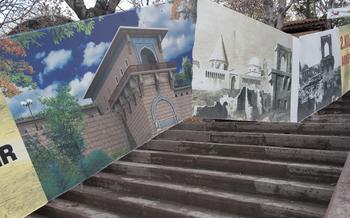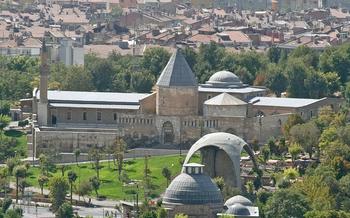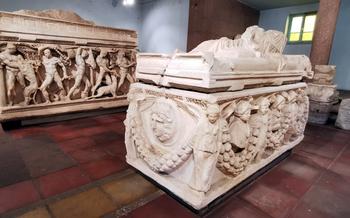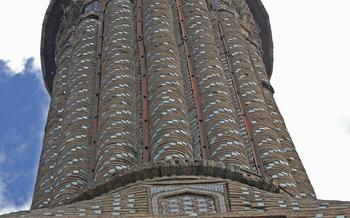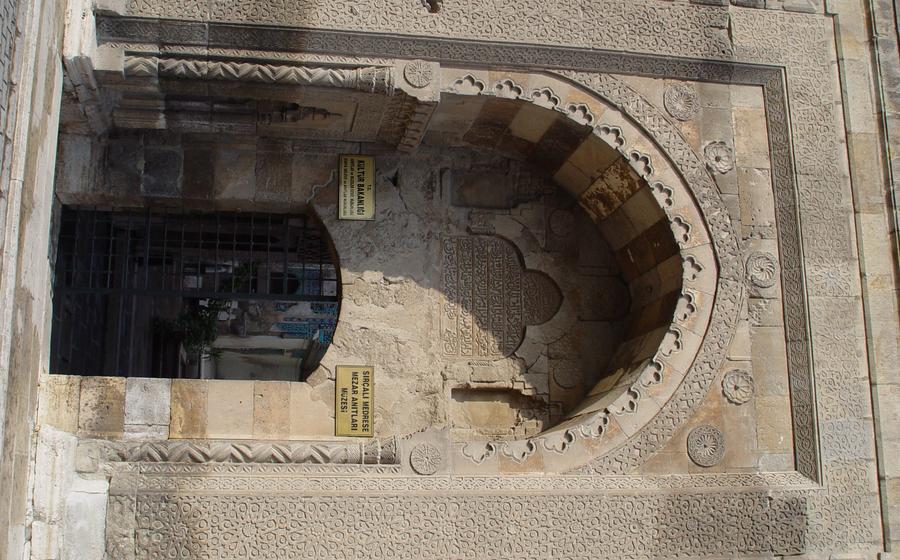
Sircali Medrese
- Historical Significance
- Architectural Highlights
- Interior Design
- Educational Importance
- Cultural Significance
- Location and Accessibility
- Visitor Information
- Photography Tips
- Historical Context
- Restoration Efforts
- Nearby Attractions
- Local Cuisine
- Souvenir Shopping:
- Accommodation Options
- Insider Tip
Historical Significance
The Sircali Medrese, a magnificent architectural masterpiece in Konya, Turkey, holds immense historical and cultural significance. Built by the Seljuk Turks in the 13th century, this medrese was a renowned center of Islamic education and scholarship. Step into its hallowed halls and explore the rich history of the Seljuk dynasty, which played a pivotal role in shaping Anatolian history. Discover the architectural marvels and artistic treasures that adorn this medrese, showcasing the splendor and sophistication of Seljuk craftsmanship. Delve into the significance of the Sircali Medrese as a testament to the enduring legacy of Islamic architecture, blending harmoniously with the unique Anatolian style.
Architectural Highlights
The Sircali Medrese is a masterpiece of Seljuk architecture, showcasing a stunning façade adorned with intricate tile work and elaborate carvings. The vast courtyard, surrounded by arched alcoves and topped with a magnificent dome, creates a sense of awe and grandeur. The ornate portal, featuring delicate muqarnas decorations and intricate calligraphy, is a testament to the skill and artistry of the Seljuk craftsmen. The unique blend of Seljuk and Anatolian architectural styles makes the Sircali Medrese a must-see for anyone interested in Islamic architecture and history.
Interior Design
The interior of the Sircali Medrese is a testament to the exquisite craftsmanship and artistic vision of the Seljuk artisans. Step into the serene prayer hall and immerse yourself in its tranquil atmosphere. Gaze upon the beautifully crafted mihrab, the focal point of the hall, adorned with intricate tile work and Quranic inscriptions. The mihrab, a niche indicating the direction of Mecca, is a masterpiece of Islamic art, showcasing the fusion of religious and aesthetic elements.
Admire the exquisite pulpit, a testament to the skill of the Seljuk woodworkers. Intricately carved with delicate patterns and inlaid with mother-of-pearl, the pulpit is a work of art that commands attention. Discover the hidden treasures of the medrese's library, a repository of knowledge and wisdom. Peruse the collection of rare manuscripts and precious books, including works on theology, philosophy, and science. These manuscripts, painstakingly preserved, offer a glimpse into the intellectual and spiritual pursuits of the scholars who once studied and taught within these walls.
Educational Importance
The Sircali Medrese was not just an architectural marvel; it was also a renowned center of Islamic learning and scholarship. It played a vital role in preserving and transmitting Islamic knowledge during the Seljuk period. The medrese offered a comprehensive education in various religious and secular subjects, including theology, law, philosophy, mathematics, astronomy, and medicine.
Famous scholars and students from across the Islamic world flocked to the Sircali Medrese to study under its distinguished faculty. Among its notable scholars were Shams al-Din al-Tusi, a renowned philosopher and scientist, and Sadr al-Din al-Qunawi, a prominent Sufi mystic and theologian. They attracted students from far and wide, creating a vibrant intellectual community within the medrese's walls.
The educational legacy of the Sircali Medrese extended beyond its time. It produced generations of scholars who went on to make significant contributions to various fields of knowledge, shaping the intellectual landscape of the Islamic world. The medrese's influence can still be felt today in Islamic scholarship and education.
Cultural Significance
Konya, the heart of Anatolian culture, is a city steeped in tradition and vibrant cultural expression. Immerse yourself in the warm hospitality of the local people, who welcome visitors with open arms and a genuine desire to share their rich cultural heritage. Discover the unique customs and traditions of the region, including the mesmerizing Sufi whirling dervishes, whose graceful movements and spiritual rituals have captivated audiences worldwide. Explore the vibrant art and music scene of Konya, showcasing the city's diverse cultural influences and the creativity of local artists. From traditional handicrafts and textiles to contemporary art exhibitions and performances, Konya offers a feast for the senses and a glimpse into the soul of Anatolia.
Location and Accessibility
The Sircali Medrese is conveniently located in the heart of Konya's historic center, amidst a vibrant tapestry of historical landmarks and cultural attractions. It is easily accessible on foot, allowing you to immerse yourself in the city's rich history and cultural heritage. For those who prefer public transportation, buses and taxis are readily available, ensuring a hassle-free journey to the medrese.
To fully appreciate Konya's beauty and pleasant weather, plan your visit during the warmer months, when the city comes alive with a myriad of colors and activities. Combine your visit to the Sircali Medrese with other nearby attractions, such as the Mevlana Museum, dedicated to the life and teachings of the renowned Sufi mystic Rumi, or explore the enchanting Sille Village, known for its unique rock formations and historic churches.
Visitor Information
Before embarking on your journey to the Sircali Medrese, it is essential to gather practical information to ensure a smooth and enriching experience. Firstly, check the medrese's operating hours and admission fees to plan your visit accordingly. Guided tours are available, providing an excellent opportunity to delve deeper into the history and significance of this architectural marvel.
While exploring the medrese, capture the beauty of its intricate details and stunning architecture through photography. However, be mindful of other visitors and maintain a respectful demeanor. Remember that the Sircali Medrese is an active place of worship and learning; hence, conduct yourself appropriately.
Photography Tips
When visiting the Sircali Medrese, don't forget to bring your camera to capture the stunning architecture and intricate details of this historic site. To make the most of your photography experience, consider the following tips:
-
Wide-angle Lens: Use a wide-angle lens to capture the vastness of the courtyard and the towering dome. This will allow you to fit more of the medrese into your frame, creating a sense of grandeur and scale.
-
Different Angles and Perspectives: Experiment with different angles and perspectives to create unique and interesting shots. Try taking photos from above, below, and from different corners of the medrese. This will help you capture the diverse architectural features and create a more dynamic visual narrative.
-
Golden Hours: Take advantage of the natural light during the golden hours, which occur around sunrise and sunset. The warm, soft light during these times can create stunning images with rich colors and deep shadows.
-
Tripod: Consider using a tripod to stabilize your camera and avoid blurry photos. This is especially important when shooting in low-light conditions or when using a telephoto lens.
-
Respect for Others: Be mindful of other visitors when taking photos. Avoid blocking their view or disrupting their experience. Be respectful of the sanctity of the medrese as a place of worship and learning.
Historical Context
The Sircali Medrese stands as a testament to the rich history and legacy of the Seljuk Turks, a powerful dynasty that ruled over Anatolia from the 11th to the 13th century. The Seljuks emerged from Central Asia and played a pivotal role in shaping the political, economic, and cultural landscape of the region. Their conquests in Anatolia laid the foundation for the establishment of a vast empire that stretched from the Mediterranean Sea to the borders of India.
The Seljuks were not only skilled warriors but also patrons of art, architecture, and scholarship. They commissioned the construction of numerous mosques, madrasas, and other religious and educational institutions, including the Sircali Medrese. These architectural marvels showcased the Seljuks' architectural prowess and artistic sensibilities, blending elements of Persian, Byzantine, and Islamic traditions to create a unique Seljuk style.
The Seljuk Empire reached its zenith under the reign of Sultan Alaeddin Keykubad I, who expanded the empire's territories and oversaw a period of great prosperity and cultural flourishing. During his reign, the Sircali Medrese was constructed as a center of Islamic learning and scholarship, attracting students from all corners of the empire.
However, the Seljuk Empire's power gradually waned in the 13th century due to internal conflicts, Mongol invasions, and the rise of other regional powers. Despite its decline, the Seljuk legacy continued to influence the region, and the Sircali Medrese remained a vital center of learning and scholarship for centuries to come.
Restoration Efforts
The Sircali Medrese has undergone extensive restoration efforts in recent years, thanks to the dedication and expertise of conservators who have worked tirelessly to preserve this architectural masterpiece. The restoration project faced several challenges, including the need to address structural damage, repair centuries-old tile work, and restore the intricate carvings and decorations that adorn the medrese. Despite these challenges, the conservators have successfully restored the Sircali Medrese to its former glory, ensuring that future generations can continue to appreciate its architectural beauty and historical significance. The restoration efforts have also had a positive impact on the preservation of Konya's cultural heritage, as they have contributed to the revitalization of the city's historic center and attracted more visitors to the region.
Nearby Attractions
In addition to the Sircali Medrese, Konya offers a wealth of other attractions that are well worth exploring. For a deeper dive into the region's history and culture, visit the Mevlana Museum, dedicated to the life and teachings of the famous Sufi mystic Rumi. This UNESCO World Heritage Site houses Rumi's tomb, as well as a collection of his personal belongings and manuscripts.
Step back in time as you explore the Sille Village, located just a short distance from Konya. Known for its unique rock formations and historic churches, this picturesque village offers a glimpse into the region's rich past. Don't miss the opportunity to visit the Pancarlik Church, with its stunning frescoes and well-preserved architecture.
Admire the architectural splendor of the Alaeddin Mosque, one of the oldest and largest mosques in Konya. Built in the 12th century, this magnificent mosque features intricate tile work, towering minarets, and a spacious courtyard. Take a moment to soak in the serene atmosphere and learn about the mosque's historical significance.
Immerse yourself in the vibrant atmosphere of Konya's traditional bazaars and markets. Here, you can find an array of local handicrafts, souvenirs, and fresh produce. Experience the hustle and bustle of the marketplace as you haggle with vendors and discover unique treasures that reflect the city's rich cultural heritage.
Local Cuisine
Indulge in the culinary delights of Konya, where traditional Turkish cuisine blends harmoniously with Seljuk and Anatolian influences. Savor the tantalizing flavors of etli ekmek, a delectable meat-filled flatbread that is a local specialty. Tantalize your taste buds with tirit, a mouthwatering dish of shredded meat swimming in a rich yogurt sauce. Experience the divine taste of Mevlana kebabi, succulent grilled lamb that embodies the essence of Konya's culinary heritage.
Immerse yourself in the vibrant atmosphere of Konya's local restaurants and cafes, where the air is filled with the enticing aromas of freshly prepared dishes. Engage with the warm and welcoming locals, who are always eager to share their culinary traditions and recommendations.
Don't miss the opportunity to delve into Turkish coffee culture. Sip on a freshly brewed cup of Turkish coffee, savoring its rich flavor and aroma. This quintessential Turkish beverage is an integral part of the local experience and a delightful way to conclude your culinary journey in Konya.
Souvenir Shopping:
Immerse yourself in the vibrant atmosphere of Konya's bazaars and markets, where you can find a treasure trove of unique souvenirs and handicrafts that reflect the rich cultural heritage of the region. Browse the colorful stalls filled with an array of traditional Turkish souvenirs, including intricately woven carpets, beautifully painted pottery, gleaming jewelry, and exquisite copperware. Support local artisans by purchasing handmade goods and textiles, each piece a testament to the skill and craftsmanship of the Turkish people. Don't forget to engage in the lively tradition of haggling with the vendors to get the best prices, adding an element of excitement to your shopping experience.
Accommodation Options
When planning your trip to Konya, you'll find a diverse range of accommodation options to suit various budgets and preferences. Whether you're a budget-conscious traveler seeking affordable lodgings or prefer the comforts of a luxurious hotel, Konya has something for everyone.
For backpackers and budget travelers, there are numerous guesthouses and hostels offering comfortable and affordable stays. These establishments often provide dormitory-style rooms or private rooms at reasonable rates. Some popular options include the Rumi Hostel, the Konya Backpackers Hostel, and the Seljuk Han Hostel.
If you prefer a more comfortable and upscale experience, Konya offers a range of hotels and resorts catering to discerning travelers. These establishments provide spacious rooms, modern amenities, and excellent service. Some highly-rated options include the Dedeman Konya Hotel, the Hilton Garden Inn Konya, and the Crowne Plaza Konya.
For those seeking an authentic Turkish experience, traditional Turkish guesthouses known as pansiyons are a great choice. These guesthouses offer a glimpse into Turkish culture and hospitality, providing cozy rooms and delicious homemade meals. Some recommended pansiyons include the Konya Pansiyon, the Mevlana Pansiyon, and the Sille Pansiyon.
No matter your budget or preferences, you're sure to find the perfect accommodation in Konya to make your stay comfortable and enjoyable.
Insider Tip
To truly immerse yourself in the serene atmosphere of the Sircali Medrese and capture its beauty without distractions, consider visiting early in the morning or late in the afternoon. During these quieter hours, you'll have the chance to wander through the medrese's courtyard and prayer hall without the throngs of tourists, allowing you to fully appreciate its architectural splendor and soak in its spiritual ambiance. Whether you're a history buff, an architecture enthusiast, or simply seeking a tranquil respite, visiting the Sircali Medrese at these times will provide a truly unforgettable experience.
